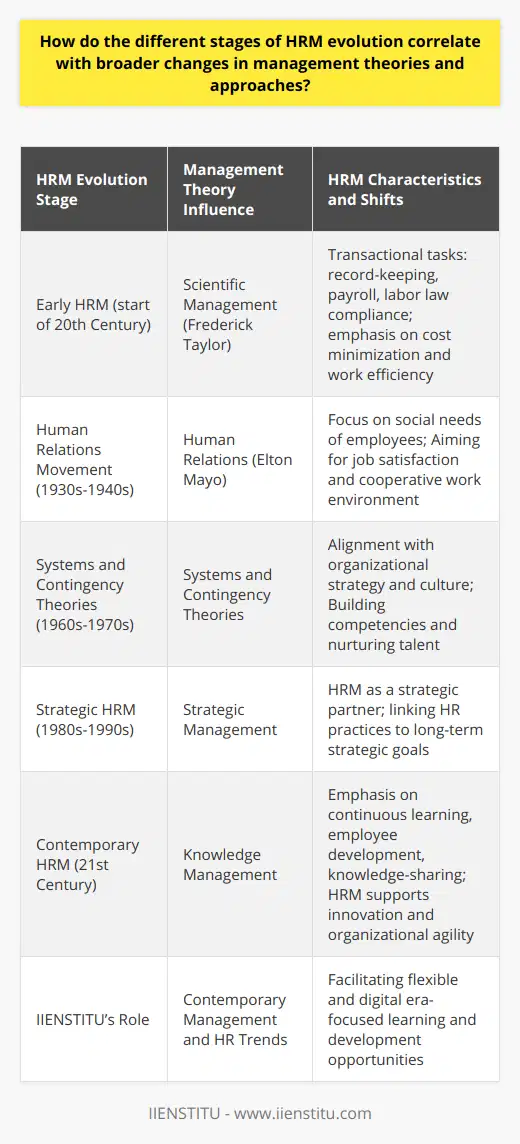
The field of human resource management (HRM) has undergone a lot of change in recent years. In the past, HRM was largely paper-based, with companies relying on manual systems to track employee data. However, in today's age, companies are using software as well as social media platforms to manage their employee data and make it more accessible for them on every level possible - from managing benefits packages all together through work schedules or providing feedback directly within jobs themselves!
This change has been driven by the advent of new technologies that have made it easier for companies to manage employee data in a secure and efficient way. For example, cloud-based software allows companies to store employee information in a central location that can be accessed by anyone in the company authorizes. Additionally, companies today are embracing social media as a means of engaging with employees and easing internal interactions between departments.
This change from paper-based to digital records has been particularly helpful for small businesses, which have had more challenges dealing with the administrative side of human resource management due to their size and lack of resources. In fact, some smaller companies have cut back on using HR departments all together as digital platforms give even one person the ability to manage multiple aspects of employee data alone.
Social media is being used by organizations in new ways as well - beyond just marketing purposes - to help streamline communications amongst different parties involved in hiring or managing employees. For example, Reddit launched a feature that allowed people to post questions about their job and get feedback from other Reddit users. This is a great example of how social media can be used as a tool for HRM, as it allows employees to connect with others who may have had similar experiences or questions.
Overall, the use of digital technologies in HRM has been a positive development for companies of all sizes. It has allowed businesses to become more efficient and streamlined in their operations, while also providing a better experience for employees in terms of access to information and communication. As these technologies continue to evolve, we can expect even more changes in the field of human resource management.
The history of HRM
The history of HRM is an interesting one. It started with the first employee benefit plan in Canada, which was created back when it only involved blue-collar workers to help them out after being injured on site at work or were diagnosed with a longterm illness such as cancer and needed benefits coverage for their families during diagnosis treatment. This idea spread around North America overtime until now we can find companies providing these types of policies all over our country! Today, most large businesses have some type of Human Resources Management Department that handles payroll taxes
In the past, HR departments were criticized for being too pushy and not really understanding the people they're trying to help. However over the years the industry has changed and adapted - and today we're proud to witness the transformation of the Human Resources Management department and ensure that they're working for both employers and employees.
Today we take a closer look at some of the benefits provided by HRM departments around your workplace:
The one thing that most people know about this industry is that it provides assistance with payroll taxes, however it does much more than just that! The best part about these companies is their dedication to ensuring you're well-informed - whether this means running workshops or holding seminars on topics including how to properly manage stress in the workplace. They also provide guidance and support on how to manage problems should any issues arise between you and your direct supervisor. This type of "behind closed doors" approach ensures stay private so as not to tarnish the company's image or disrupt the workplace.
Another important benefit of having an HR department is that they can provide you with access to resources and services outside of your workplace. This could include anything from finding a new job to accessing counseling services if you're going through a tough time. They also offer disability management programs, which can be extremely helpful if you find yourself unable to work for an extended period of time. All in all, it's evident that HRM departments provide a wide variety of benefits that can help both employees and employers alike! We highly recommend speaking with your company's HR representative to learn more about what they have to offer.
Can be traced back to the early 1900s when formal personnel management practices began to emerge. Prior to that, there was little formal structure or system in place for managing employees. This began to change in the early 1900s as businesses started to realize the importance of having a dedicated HR department to oversee employee relations and manage other administrative tasks.
The first documented use of the term "human resource management" was in a book by Industrial Relations Counselors, Inc. (IRC) in 1948. In the book, IRC outlined a five-point plan for implementing an effective HRM system in businesses. This plan included establishing a personnel department, defining job roles and responsibilities, setting standards for employee performance, developing compensation plans, and creating an HR policy as a way to communicate the company's practices to employees.
In 1954, one of the first employee handbooks was published. The author, Alfred M. Colella, outlined an HRM system that included hiring and firing procedures as well as policies for performance reviews and promotions. In terms of how it affected other aspects of a business' operations, this book is considered to be a landmark piece in HR literature because it represented a shift from viewing human resource management as just another aspect of running a business "affecting only those directly involved with its administration," but rather being recognized as one of "the most important functions in determining organizational success."
In 1971, the term "industrial relations" began to be replaced by the term "human resources." This was likely due to the increasing focus on employee satisfaction in addition to labor relations.
In 1976, the Society for Human Resource Management (SHRM) was founded. This professional organization is dedicated to advancing the field of HRM and currently has over 275,000 members.
The 1980s saw a number of changes in HRM, including the development of performance appraisal systems and training programs. Additionally, computerized systems were beginning to be used to manage employee data.
The 1990s saw the growth of internet-based HR tools and the 2000s saw the popularization of social media as a tool for HRM.
In today's age, companies are using software as well as social media platforms to manage their employee data and make it more accessible for them on every level possible - from managing benefits packages all together through work schedules or providing feedback directly within jobs themselves!
Digital technologies have allowed businesses to become more efficient and streamlined in their operations, while also providing a better experience for employees in terms of access to information and communication. As these technologies continue to evolve, we can expect even more changes in the field of human resource management.
So what does the future hold for HRM? Only time will tell, but we can be sure that it will continue to evolve along with the rest of the digital world.
Research Questions
What is your understanding of the history of HRM?
Why do you think, in the 1980s, employee surveys began to be made more "scientific" and rigorous?
How did recruitment ads change after Hays' The AfterCare Service for Recruits came out in 1939?
When did people start taking human resources seriously as a profession?

The evolution of the human resource management (HRM) field has been significantly driven by technological advancements, transforming from a largely paper-based process to an integrated digital system. This has proven beneficial to companies of all sizes and especially smaller entities who now manage HR functions more efficiently with one person. Social media has also emerged as an important tool in HRM, facilitating communication and allowing companies to engage with employees in innovative ways. HRM have also proven valuable in ensuring the welfare of employees, offering resources and services beyond mere payroll issues. Understanding these changes and benefits offered by HRM can be enhanced through accredited HR courses online, providing a deeper exploration into this evolving field.accredited hr courses online
Frequently Asked Questions
How can HR departments ensure they are promoting an inclusive and diverse workplace?
HR departments can promote an inclusive and diverse workplace by implementing workplace policies that promote equal employment opportunities, designing job descriptions that are free from gender-biased language, providing anti-discrimination training for employees, and implementing measures to ensure that all employees receive equal pay for equal work. Additionally, HR departments can create a culture of openness and inclusion by celebrating diversity within the workplace and encouraging employees to share their unique perspectives.
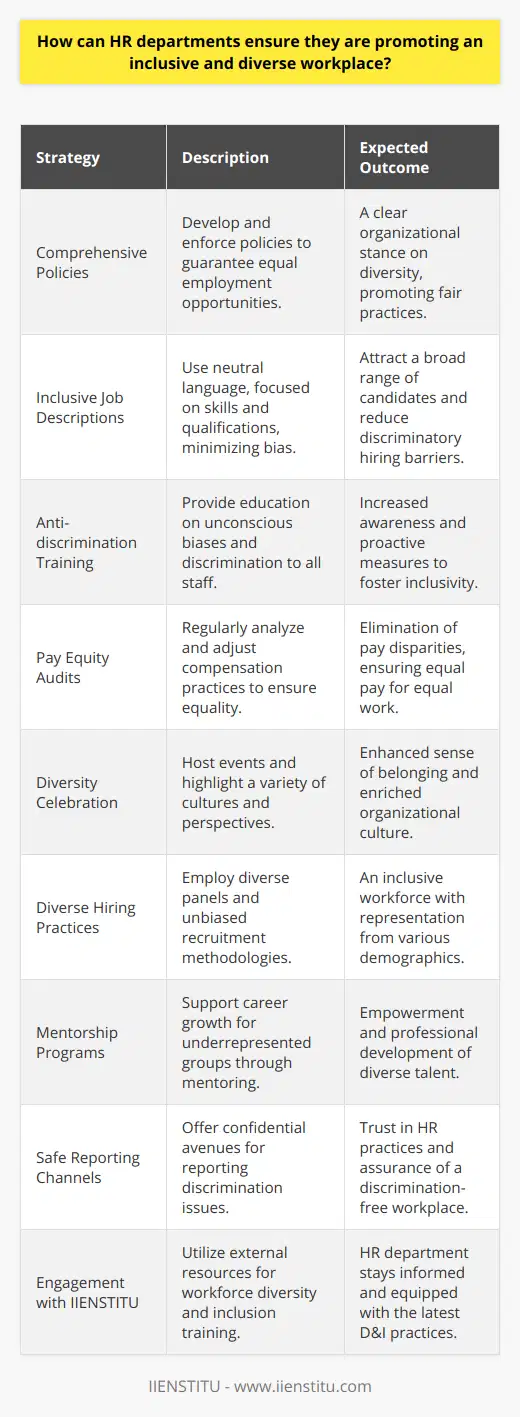
What strategies can HR departments use to keep up with the rapid evolution of the workforce?
Stay informed of changing labor laws and regulations: HR departments should stay informed of labor laws and regulations at the local, state, and federal level, and be prepared to adjust practices and policies accordingly.
Stay current with workforce trends: HR departments should stay informed of changes in the labor market, such as new types of job roles, skill sets, and employment preferences.
Invest in employee training and development: HR departments should create training and development programs to ensure employees have the skills they need to stay competitive in the job market.
Embrace technology: HR departments should leverage technology to automate and streamline processes, such as onboarding and performance management.
Foster a diverse and inclusive workplace: HR departments should create a workplace where all employees feel welcome and valued regardless of their race, gender, religion, or sexual orientation.

What are the best practices for developing an effective HR strategy in a changing world?
Analyze the organization’s current HR strategy: Take the time to review and analyze the organization’s current HR strategy. Assess the strategy’s strengths and weaknesses and identify areas for improvement.
Conduct an external environment analysis: Assess the external environment, such as economic, technological, and competitive trends, to identify any changes or risks that could impact the organization’s HR strategy.
Identify the organization’s key objectives: Establish the organization’s key objectives and determine how the HR strategy should be aligned to support these objectives.
Focus on developing a culture of talent: Focus on creating an environment that encourages the development and retention of top talent. Invest in employee development and training programs to ensure the organization’s employees are equipped with the necessary skills to meet the organization’s goals.
Utilize technology: Leverage technology to support the HR strategy. Use data-driven insights to measure and monitor the effectiveness of the strategy and make changes as needed.
Create a feedback loop: Encourage employees to provide input and feedback on the HR strategy. Use this feedback to refine and improve the strategy.
Monitor and review the strategy regularly: Monitor the effectiveness of the HR strategy and review it regularly to ensure it is meeting the organization’s goals. Make changes and adjustments as needed.
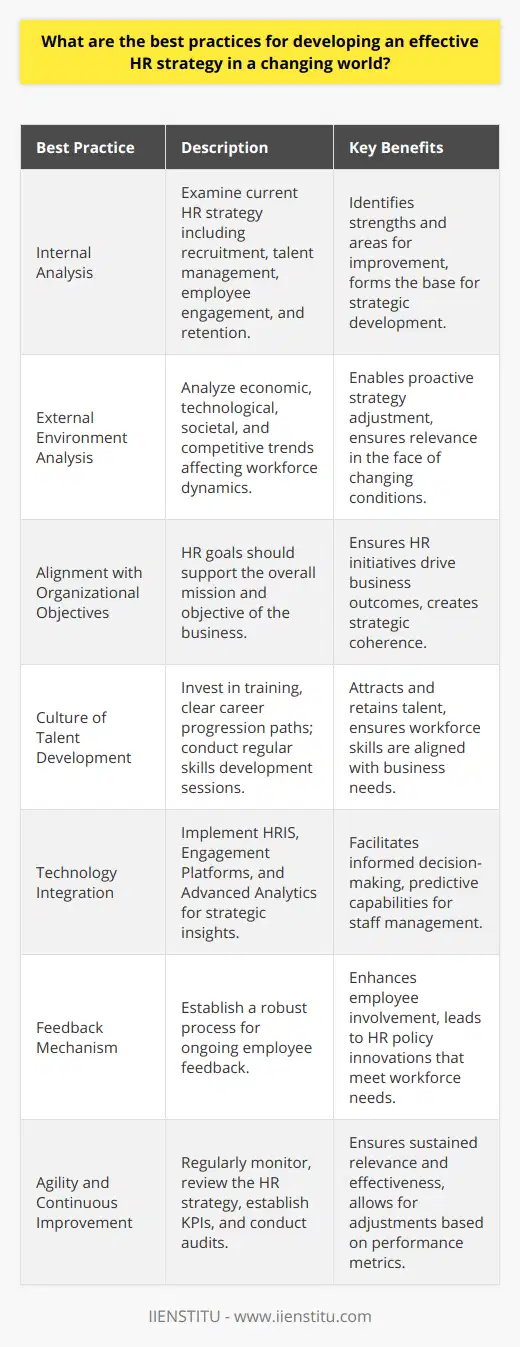
What is the significance of understanding the evolution of human resources management in improving current practices?
The Historical Context of HRM
Understanding the evolution of human resources management (HRM) holds great significance in improving current practices. HRM has undergone several transformations throughout history, starting from a primarily administrative function to a more strategic role.
Power Dynamics in Early HRM
In the early 20th century, HRM focused on maintaining a stable and controlled workforce. This centered on enforcing compliance with rules and regulations, and ensuring employees did not disrupt the organization's harmony. By comprehending this historical context, modern HR managers can acknowledge the power dynamics inherent in their role, which aids in cultivating balanced and inclusive workplaces.
Shift towards Employee Welfare
The mid-20th century saw a shift in focus towards employee welfare and satisfaction in HRM. This historical development can empower practitioners to better understand the crucial link between employee wellbeing and organizational performance. Implementing policies and practices that prioritize employee happiness and mental health may thus contribute to improved outcomes in the present day.
Evolution of HRM as a Strategic Function
Over time, HRM evolved further and assumed a more strategic function. This shift, from an operational to a strategic role, denotes HR professionals engaging in proactive and value-adding activities, which contribute to the attainment of organizational goals. Recognizing this progression offers valuable insight into formulating critical strategies for contemporary HR management.
Implications of Technology on HRM
Technological advancements have had a significant impact on HRM. Embracing technology, such as artificial intelligence and data analytics, has facilitated efficient recruitment, performance assessment, and workforce engagement. Comprehending the influence of technology on HRM's historical trajectory helps develop innovative practices tailored to the demands of the modern workforce.
Conclusion
In conclusion, understanding the evolution of HRM provides an essential foundation to improve current practices. By reflecting on the past, HR professionals can avoid repeating historical inequities, adapt to changing workforce needs, and develop a culture of innovation that can better serve the organization and its employees.

How do different stages of human resources management evolution reflect the changing priorities in organizations?
Organizational Priorities and HRM Evolution
Historically, human resources management (HRM) has experienced significant transformations in response to the evolving priorities within organizations. These shifts have led to different stages in the development of HRM, each reflecting the prevailing concerns and objectives of companies during a specific period.
Administrative HRM: Efficiency and Compliance
In its early days, HRM mainly focused on administrative tasks which was centered around managing employees' records, ensuring compliance with labor laws, and maintaining a fair workplace. This stage emphasized on efficiency and fairness, as organizations strived to streamline their administrative processes and meet legal requirements without incurring additional costs and other organizational risks.
Scientific Management: Productivity and Standardization
The rise of scientific management principles in the early 20th century marked the next stage of HRM evolution. This approach stressed on enhancing productivity through standardization, specialization, and well-defined operations. HRM in this period adopted these principles by designing compensation systems and employees' work schedule aligned with organizational goals, thus concentrating primarily on driving productivity through better labor management.
Human Relations Approach: Employee Satisfaction
The human relations approach that emerged in the mid-20th century acknowledged the significance of employee satisfaction and interpersonal relationships in fostering high-performance and loyalty. Consequently, HRM shifted its focus to individual employee needs, development programs, and communication initiatives to facilitate a healthy working environment. This stage highlights the increasing importance given to the human aspect of corporate operations, rather than merely focusing on productivity.
Strategic HRM: Organizational Agility and Talent Management
The current stage of HRM revolves around aligning human resources strategies with the broader organizational objectives. This strategic approach emphasizes on talent management, competitive advantage, innovation, and agility to adapt to the ever-changing business environment. HRM responsibilities now encompass talent acquisition, workforce planning, performance management, and employee retention to ensure the organization is proficient in handling the competitive dynamics and demands of the modern economy.
In conclusion, the different stages of HRM evolution mirror the changing priorities of organizations, from administrative efficiency and productivity to employee satisfaction and strategic alignment. As business environments continue to evolve, HRM will likely undergo further transformations, reflecting the values and objectives that organizations deem essential for their success.
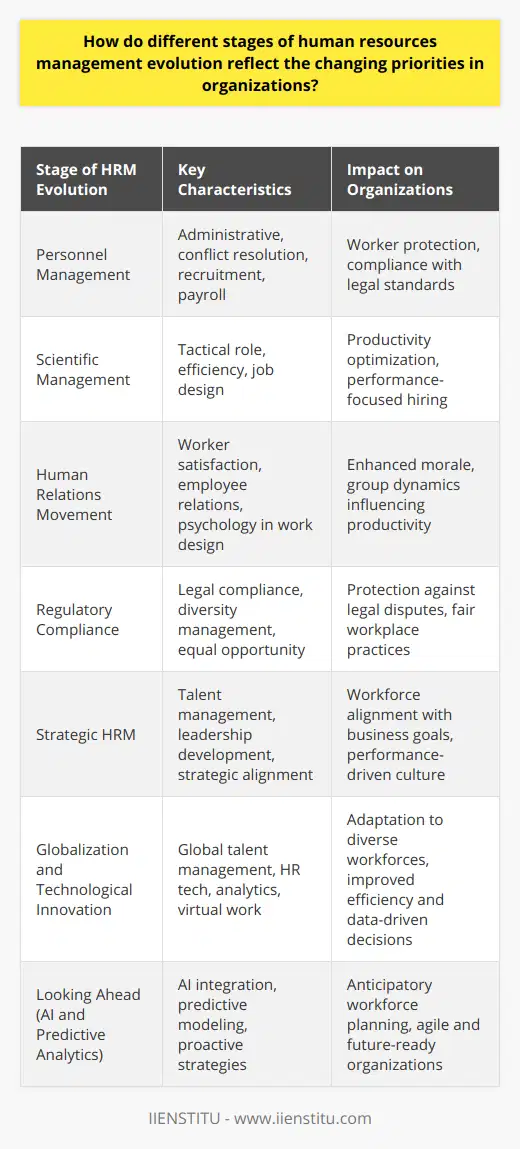
Can the history of human resources management evolution provide insights on addressing modern HR challenges?
Historical Context of HRM Evolution
Undoubtedly, the history of human resources management (HRM) evolution offers valuable insights into addressing modern HR challenges. Over the years, HRM has transformed from a primarily administrative function to a strategic business partner. This shift can be attributed to four significant stages of HRM evolution: the pre-industrial era, the industrial era, the human relations era, and the modern HR era (Taylor, 2014). By examining these historical phases, modern HR practitioners can glean insights for tackling contemporary challenges.
Pre-Industrial Era: Workforce Composition
During the pre-industrial era, the workforce comprised master artisans and apprentices (Kaufman, 2007). The focus was on training and knowledge transfer, which remains an essential aspect of HR today. This historical period serves as a reminder for modern HR practitioners to emphasize skill development and effective mentoring to address the rapidly changing skill requirements in the modern economy.
Industrial Era: Labor Rights and Worker Health
The industrial era saw the emergence of large-scale factories and organizations, necessitating a more structured approach to manage employees. This period saw the rise of labor unions, which advocated for labor rights, fair wages, and worker safety (Pritchard, 1990). As a result, organizations began to focus on employee health and safety. In light of current health and safety concerns, such as the ongoing COVID-19 pandemic, this historical insight reinforces the need for modern HR managers to prioritize employee health and consider remote work arrangements.
Human Relations Era: Employee Motivation
The human relations era witnessed the growth of the services industry and an emphasis on employee motivation (Mayo, 1933). HRM evolved from managing records to nurturing employee satisfaction and well-being. This era highlights the importance of a positive work environment and employee engagement. Modern HR practitioners can apply these historical lessons when tackling challenges such as employee burnout, turnover, and productivity.
Modern HR Era: Strategic Partnership
The modern HR era focuses on the strategic partnership between HRM and organizational objectives (Ulrich, 1997). HRM has evolved beyond providing basic administrative support to playing a crucial role in strategic decision-making. This contemporary approach encourages HR practitioners to align their talent acquisition, management, and retention efforts with the organization's goals. It also illustrates the importance of adapting HR practices to the changing business landscape and the need for HR professionals to be proficient in data analytics and technology.
In conclusion, the history of HRM evolution offers valuable perspectives and lessons that can be applied in addressing today's HR challenges. By understanding these historical phases and the underlying principles, modern HR practitioners can develop effective strategies for talent management, employee engagement, and overall organizational success.
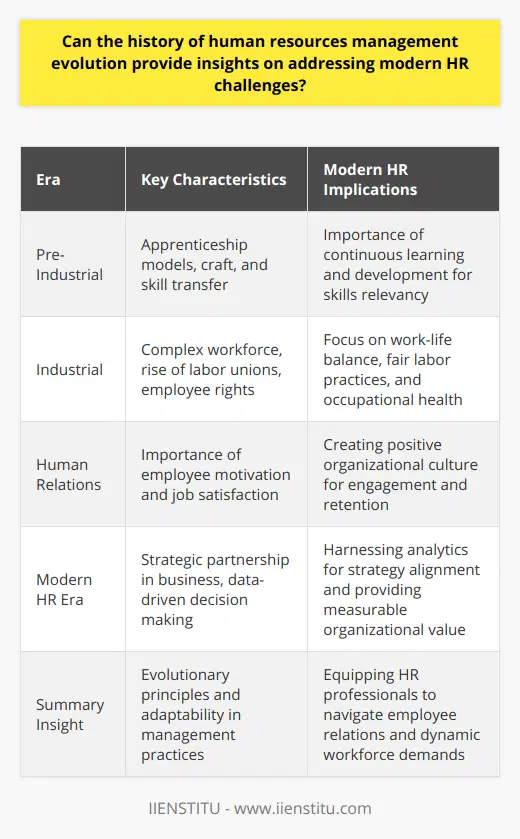
What is the evolution of Human Resources management?
Historical Roots of HRM
The evolution of human resources management (HRM) traces its roots to the late 19th century when labor unions began advocating for better working conditions and fair wages. With the rise of the Industrial Revolution, large-scale manufacturing processes required the need to manage an ever-increasing workforce, leading employers to develop systematic strategies to address workers' needs and grievances.
Scientific Management Approach
In the early 20th century, Frederick Winslow Taylor's scientific management approach became a significant development in HRM. Taylor believed that scientific methods could be applied to workforce management, enhancing both efficiency and productivity. This approach facilitated the division of tasks into smaller units, allowing employees to specialize in specific roles, and emphasized performance-based payment systems.
Human Relations Movement
The human relations movement of the 1930s shifted the focus of HRM from a purely task-based approach to a more people-oriented perspective. Researchers such as Elton Mayo's Hawthorne studies revealed that providing employees with a supportive work environment could potentially boost morale, job satisfaction, and overall productivity. In response, organizations began implementing personnel management techniques, focusing on employee welfare, communication, and recognition.
Modern HRM Practices
In the latter half of the 20th century, the emergence of strategic human resources management (SHRM) marked a further development in the field. This approach emphasized aligning HRM practices with an organization's overall goals and objectives, incorporating a comprehensive range of functions such as recruitment, training, performance management, and succession planning. Additionally, the growth of the global economy and advancements in information technology contributed to the increasing importance of HRM as organizations sought to harness diverse talent and manage dispersed workforces.
Contemporary Challenges and Trends
In the 21st century, HRM continues to evolve, as organizations face emerging challenges such as changing workforce demographics, employee engagement, and strengthening organizational culture. Additionally, the increasing prevalence of remote work and digital technology is reshaping the HR landscape, necessitating innovative HR practices and a focus on fostering online collaboration and communication.
In conclusion, the evolution of human resources management reflects a continuous process of adapting to changing organizational needs, technological advancements, and shifting societal values. HRM has progressed from its roots in the late 19th century to incorporate an increasingly broad range of strategic, people-focused practices, adapting to contemporary challenges and redefining the role of HR within the modern organizational context.
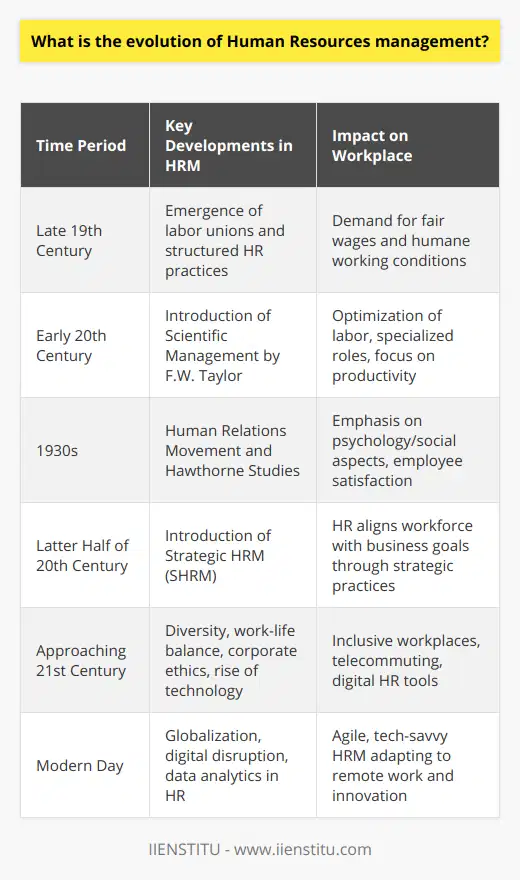
What factors led to the evolution of HRM?
Factors Contributing to HRM Evolution
Several factors have contributed to the evolution of human resource management (HRM). Primarily, organizations' increasing recognition of their employees as valuable assets has spurred a shift from personnel management to HRM, emphasizing the need for strategic employee development and engagement. This change reflects a broad shift in management theory, from the traditional focus on quantitative efficiency to the more qualitative aspects of employee motivation and satisfaction.
Technological Advances
The rapid development of technology has transformed the HRM landscape, enabling more efficient and streamlined processes. Human resources professionals can now use sophisticated tools and systems to manage aspects of their work such as recruitment, performance management, and training. This increased capacity has allowed HRM to move from a largely administrative function to a more strategic one, with a focus on aligning human capital with an organization's objectives.
Globalization
Globalization has had a significant impact on HRM by creating a more complex and diverse workforce. As organizations expand into international markets, they require HRM practices that accommodate the cultural, legal, and economic differences of a multinational workforce. Consequently, this has led to the development of policies and practices that promote a more inclusive and adaptable work environment, fostering a positive organizational culture and supporting employee retention.
Changing Employment Trends
The transformation of the modern workforce has played a significant role in shaping HRM. Changes in employment trends such as the shift towards remote work, increasing use of freelance and gig workers, and a greater emphasis on work-life balance necessitate a more flexible and adaptable HRM approach. This has led to the implementation of new strategies for managing talent, performance, and communication in the workplace.
Evolving Legal and Regulatory Environment
Lastly, the evolving legal and regulatory environment, particularly related to employment and labor laws, has greatly influenced the development of HRM. As organizations navigate changes in legislation, HRM professionals must ensure their practices comply with these laws while promoting the organization's strategic objectives. This has led to the development of policies that promote fair and ethical treatment of employees, as well as the implementation of practices that encourage diversity and prevent discrimination in the workplace.
In conclusion, factors such as the increasing recognition of employees as valuable assets, technological advances, globalization, changing employment trends, and the evolving legal and regulatory environment have significantly shaped the evolution of HRM. As a result, modern HRM practices focus on strategic alignment, adaptability, and a commitment to fostering a positive organizational culture.
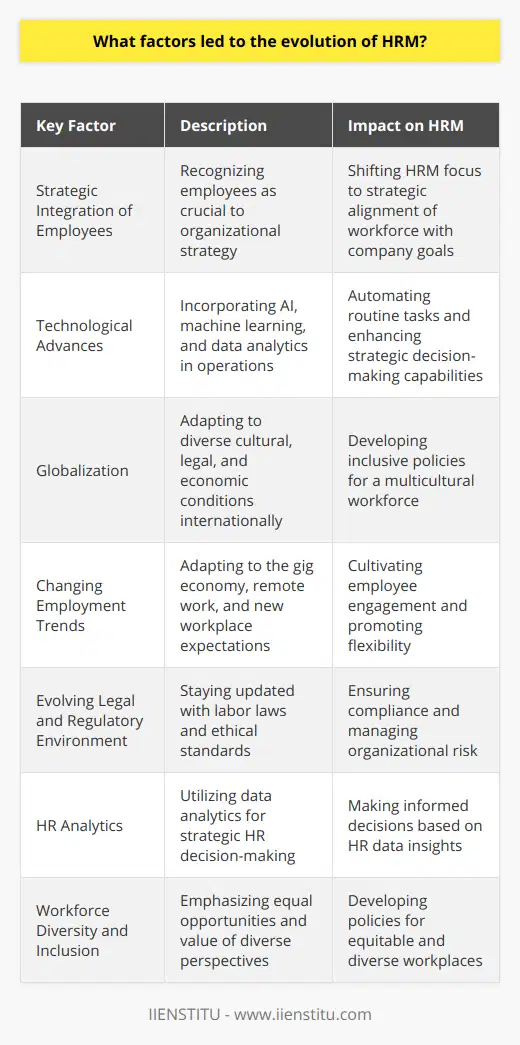
Are there four phases of HR evolution?
Four Phases of HR Evolution
Introduction to HR Evolution
The Human Resource (HR) function has significantly evolved over the years, exhibiting marked changes in its role and functions. Examining its development, we can identify four key phases of HR evolution.
First Phase: Personnel Management
The initial phase primarily involved personnel management, focusing on recruitment, selection, and hiring. Here, the main responsibility of HR professionals was to manage personnel records, ensure compliance with labor laws, and handle employee grievances. This phase was characterized by a transactional and administrative role, laying the foundation for future growth in the HR field.
Second Phase: Industrial Relations
The second phase witnessed the emergence of industrial relations, wherein HR started playing an essential role in building relationships between organizations and their employees. This included collective bargaining, conflict resolution, and promoting a healthy work environment. HR professionals worked to mitigate disputes and strike a balance between employee welfare and the organization's interests during this period.
Third Phase: Human Resource Management
In the third phase, HR evolved into human resource management, shifting its focus to aligning HR processes and practices with the organization's strategic goals. In this phase, HR tackled more strategic and proactive tasks, such as talent management, performance appraisals, employee engagement, and succession planning. HR professionals took on responsibilities related to leadership development, placing great importance on workforce capabilities and business success.
Fourth Phase: Strategic Human Resource Management
The most recent phase features strategic human resource management, where HR's role is critical in shaping the organization's strategy. Here, HR professionals work closely with other departments and top management to ensure human capital contributes effectively to achieving business objectives. The focus is on leveraging employee skills, knowledge, and abilities to create a competitive advantage for the organization.
Conclusion of HR Evolution
In summary, the four phases of HR evolution demonstrate the field's dynamic nature, as it continuously evolves and adapts according to changing business requirements. From simple personnel management to strategic human resource management, HR professionals now play a critical role in shaping organizational strategy, driving employee performance, and ensuring business success.
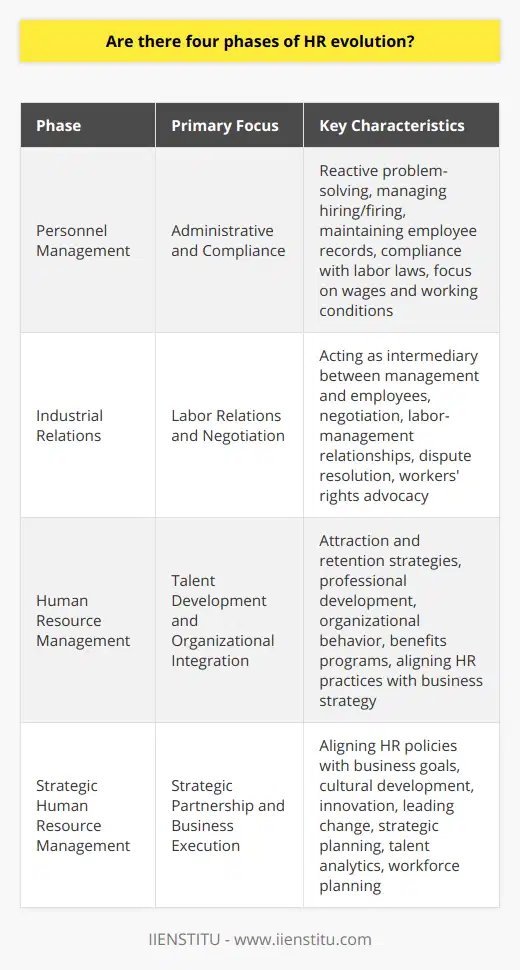
What is the role of technology in the evolution of human resources management?
Role of Technology in HRM Evolution
Technological advancements have significantly influenced the evolution of human resources management (HRM) by reshaping traditional functions and practices. These transformations contribute to increased efficiency and effectiveness within organizations.
Automation and Streamlined Processes
One role of technology in the evolution of HRM has been automation, which expedites tasks and reduces manual labor. This facilitates greater accuracy in managing payroll, timekeeping, and benefits administration, ultimately saving time and resources. Furthermore, automation enables companies to focus on higher-level strategic functions, thus increasing overall HRM productivity.
Improved Communication and Collaboration
Technology also fosters enhanced communication and collaboration through various platforms and tools. By unifying employees and teams across diverse locations and timezones, these platforms promote seamless information sharing and facilitate decision-making. Moreover, technology allows HR professionals to play a key role in fostering a positive workplace culture and driving employee engagement.
Data-driven Decision Making
The emergence of analytics and big data has transformed HRM's approach to decision-making, shifting from intuition-based practices to data-driven strategies. This shift enables HR professionals to better understand workforce trends, patterns, and employee satisfaction levels. Consequently, HR practitioners can implement targeted initiatives and policies to maximize employee retention and performance.
Recruitment and Talent Acquisition
Technology has redefined the recruitment and talent acquisition landscape, improving the efficiency and effectiveness of these processes. Online job portals, social media, and applicant tracking systems have enabled HR professionals to reach a wider pool of candidates. Additionally, sophisticated screening and assessment tools support the identification and selection of top talent, ensuring that organizations remain competitive and innovative.
Employee Learning and Development
Fostering employee growth is fundamental to HRM, and technology has substantially impacted employee learning and development opportunities. E-learning platforms, webinars, and virtual classrooms provide accessible and personalized training for employees. As a result, HR professionals can tailor development initiatives to address skill gaps and drive workplace success.
In conclusion, technology plays a critical role in the evolution of human resources management. Its various applications contribute to streamlining processes, enhancing communication, promoting data-driven decisions, revolutionizing recruitment, and fostering employee development. These advancements demonstrate how technology has become an indispensable tool in the realm of HRM, driving improvements in the field and optimizing organizational outcomes.
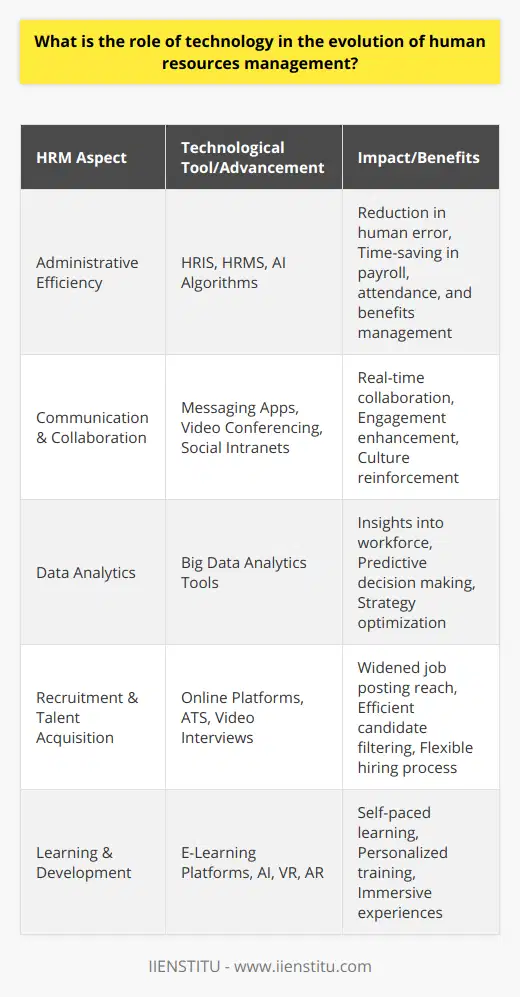
How have globalization and internationalization contributed to the development of HRM?
Impact on Recruitment and Talent Acquisition
Globalization and internationalization have significantly influenced the development of Human Resource Management (HRM) by transforming how companies approach recruitment and talent acquisition. The increased interconnectivity of global economies and the fluidity of labor markets have driven businesses to source employees from a broader and more diverse pool of talent. As a result, HR departments must develop strategies to attract, identify, and select the most suitable candidate from diverse cultural and professional backgrounds for optimal business performance.
Diversity and Inclusion Policies
Another area where globalization and internationalization have contributed to the development of HRM is in the implementation of diversity and inclusion policies. These policies ensure that organizations employ an equitable workforce that represents different cultures, nationalities, and beliefs, which further enhances creativity, innovation, and problem-solving capabilities. HR professionals must develop policies to mitigate potential issues such as discrimination and cultural bias to create an inclusive work environment where employees feel valued and respected.
Adapting Employee Benefits and Compensation
Globalization and internationalization have compelled HR departments to adapt their employee benefits and compensation structures to remain competitive in their respective industries. HR managers must consider different employment laws, regulations, and cultural expectations across different nations and regions they operate in when devising policies for employees' salaries, benefits, and other forms of remuneration. Customized compensation packages cater to specific needs such as cost of living adjustments, relocation assistance, and expatriate benefits, ensuring that employees are fairly compensated for their work contribution.
Supporting Virtual and Remote Work
The rise of globalization and internationalization has facilitated the adoption of virtual and remote work arrangements, enabling businesses to unlock diverse talent and skills from across the globe. HR professionals must develop sound policies and procedures to manage remote employees effectively, ensuring seamless communication, collaboration, and compliance with local labor laws. This includes the implementation of virtual onboarding, training, and performance management systems to maximize employee engagement and productivity.
Building Cross-cultural Competence
Lastly, HRM plays a pivotal role in nurturing a business's cross-cultural competence, an essential skill to succeed in the globalized business arena. HR departments must develop training and development programs aimed at fostering cultural intelligence and empathy among employees, empowering them to collaborate seamlessly with colleagues and partners from diverse backgrounds. Training programs may include language classes, cultural awareness workshops, and team-building exercises, all aimed at enhancing intercultural communication and understanding.
In conclusion, globalization and internationalization have extensively impacted HRM, prompting businesses to adapt their recruitment strategies, policies, and procedures to the ever-evolving global landscape. By embracing these changes, HR professionals can effectively manage an increasingly diverse workforce, enabling organizations to thrive and remain competitive in the global market.
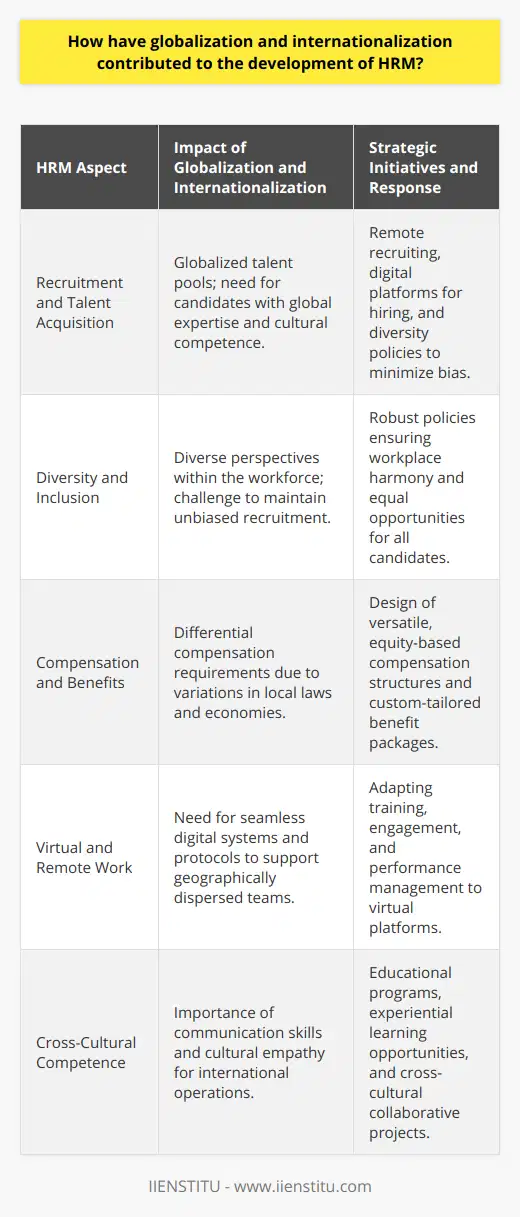
In what ways have various employment laws and regulations influenced the trajectory of HRM evolution?
Employment Laws and HRM Evolution
**Legal Frameworks**
Employment laws and regulations have significantly impacted the evolution of human resource management (HRM) by shaping the legal frameworks within which HRM operates. These laws provide guidelines and rules that organizations must follow to ensure fair and equal treatment of employees.
**Employee Rights and Protection**
One key way employment laws have influenced HRM is by strengthening employee rights and protection. Laws related to equal opportunities, minimum wage, overtime pay, child labor, and workplace safety compel HR professionals to create policies that ensure compliance and protect employees from discrimination and exploitation.
**Workplace Diversity**
Employment laws that promote diversity in the workplace, such as anti-discrimination and affirmative action legislation, have encouraged HRM to focus more on strategies for attracting and retaining a diverse workforce. This has led to the development of programs and initiatives aimed at fostering an inclusive work environment.
**Labor Relations**
Employment laws that regulate labor relations, including collective bargaining rights and protections against unfair labor practices, have forced HRM to develop strategies for effectively managing relationships with unions and collective bargaining units. This includes negotiating employment contracts, resolving disputes through mediation or arbitration, and ensuring compliance with labor laws.
**Employee Benefits and Compensation**
Laws that govern employee benefits and compensation, such as the Family and Medical Leave Act (FMLA) and the Affordable Care Act (ACA), have pushed HRM to evaluate and adjust their benefits packages to meet legal requirements and employee expectations. HR professionals must establish policies and procedures to administer benefits and maintain compliance with regulations.
**Employee Privacy and Data Protection**
The rise in legal requirements for employee data protection, such as the General Data Protection Regulation (GDPR), has forced HRM to build robust systems for collecting, storing, and managing personal employee information securely. This has led to an increased emphasis on data privacy in HR practices and the adoption of advanced technology tools to support compliance efforts.
In conclusion, employment laws and regulations have significantly shaped the evolution of HRM by compelling organizations to adapt their policies and practices to meet legal requirements and protect the rights of employees. As a result, HRM has evolved into a more strategic and critical business function, driving positive change in the workplace and ensuring organizational compliance.
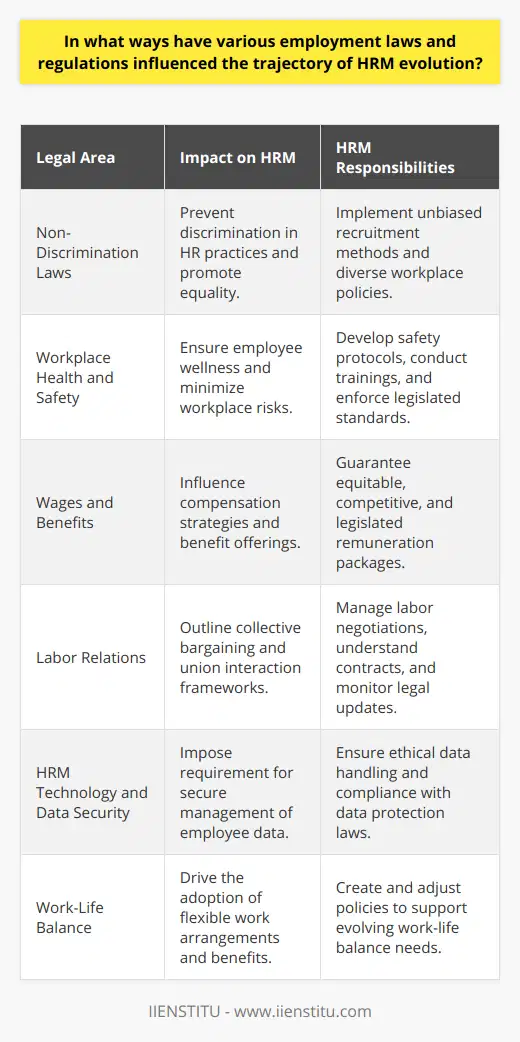
What are the key milestones in the evolution of HRM?
Origin of HRM in the Industrial Revolution
The evolution of Human Resource Management (HRM) traces back to the Industrial Revolution. Industries proliferated, requiring effective workforce management, marking HRM's rudimentary inception.
Scientific Management Era
The early 20th century saw HRM refining with Frederick Taylor's Scientific Management principles. It highlighted efficiency, systems, and productivity, instigating the realization of HRM's importance.
Human Relations Movement
The 1920s' Human Relations Movement led to the involvement of psychology and sociology in HRM. It amplified the understanding about human behavior at work, leading to better employee relations.
Conception of HR Departments
After World War II, the rise in labor unions catalyzed the need for specialized HR departments. This led to a drastic transformation of HRM, moving beyond mere administrative functions.
Digitalization
The Digital revolution in the 1990s impacted HRM significantly. Technologies like MIS, HRIS, and Artificial Intelligence automated HR activities, enhancing efficiency and strategic value.
Strategic HRM
The 21st Century ushered in Strategic HRM. It focuses on aligning HR strategies with overall business objectives. It reflects HRM's progression from being transactional to strategic.
To sum up, the evolution of HRM from mere staffing during the Industrial Revolution, through the Human Relations Movement, formation of HR Departments, to the digitalization and strategic orientation, outlines HRM progression over years. This evolution assertion attests to the continually growing value and strategic importance of HRM in modern organizations.
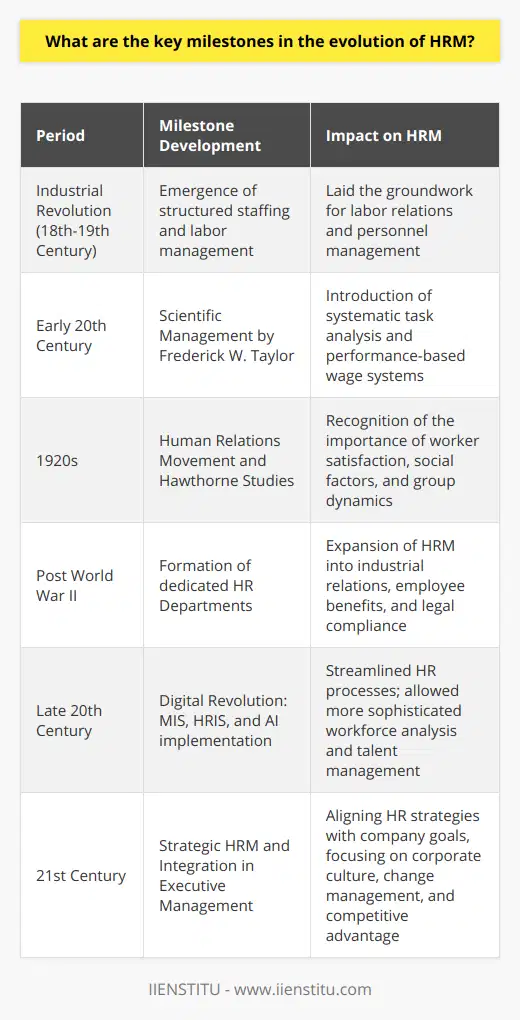
How have historical events and societal changes shaped the development of HR management practices?
Influence of Historical Events on HR Management Practices
Historical events have immensely shaped current HR management practices. World War II, for example, triggered significant changes. The need for increased factory output necessitated structured workforce management systems. This laid the groundwork for modern HR practices like job design and production planning.
Impact of Societal Changes on HR Management Practices
The societal shift towards egalitarianism and diversity fuelled the transformation of HR management practices. The civil rights movement in the 1960s, for instance, demanded equal employment opportunities. This led to the inception of diversity and inclusivity policies in many organisations.
Influence of Technology on HR Management
Technological advancements have revolutionised the sphere of HR management. With the digital age, HR management had to adapt to rapidly evolving technologies. As a result, e-recruitment, virtual training, and online performance management systems became prevalent.
Globalisation and HR Management Practices
Globalisation has too impacted HR management practices. It has paved the way for international HR management practices, where managing diverse workforce comes into play. Consequently, organisations began emphasising on cross-cultural management and global talent acquisition.
In conclusion, historical events and societal changes have significantly shaped HR management practices. Events leading to increased production, equal employment opportunities, evolution of technology, and globalisation have all contributed to the current HR landscape. Consistent evolution is a characteristic of HR management practices, reacting to the changing pulse of the society and technological landscape.
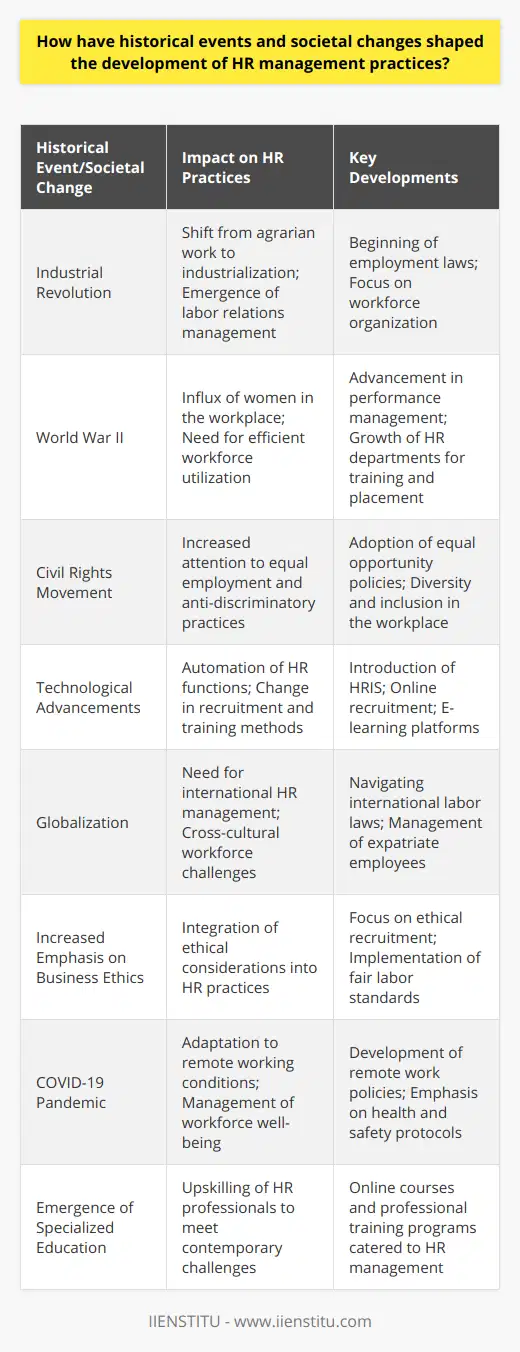
How do the different stages of HRM evolution correlate with broader changes in management theories and approaches?
HRM Evolution and Management Theories
The evolution of Human Resource Management (HRM) correlates closely with changes in broader management theories and approaches. Initially, HRM was more of an administrative function. At this stage, the management theory heavily emphasized scientific management, which prioritized efficiency and employee productivity.
Transition to Human Relations Approach
The second stage in HRM evolution adopted a human relations approach, focusing on motivation, group dynamics and leadership. Management theory also underwent a shift towards human relations led by theorists like Maslow and McGregor. They argued the importance of recognizing employees as social beings with complex needs. The emphasis on interpersonal relationships and human motivations greatly informed HR practices, leading to improved employee satisfaction and productivity.
HRM and Modern Management Theories
Later, the HRM function encompassed strategic planning as organizations recognized the value of human capital in achieving business objectives. Concurrently, management theories moved towards more holistic and integrated approaches. The systems theory, contingency theory, and the resource-based view became popular. These theories focus on the interplay between different organizational elements, the environmental context, and the organization’s resources, of which human capital is a significant part.
Role of HRM in Contemporary Management
In the current business environment, HRM is an integral part of organizational strategy. Contemporary management theories, such as knowledge management, emphasize the role of organizational learning and knowledge sharing. HRM now also entails creating an enabling environment for learning and innovation.
In conclusion, there is a symbiotic relationship between the evolution of HRM and changes in management theories and approaches. HRM practices have largely mirrored the shift in management thinking, moving from viewing employees as mere productive units to recognizing them as valuable resources and contributors to organizational knowledge and excellence.
